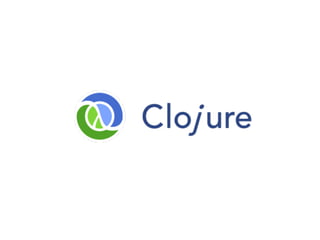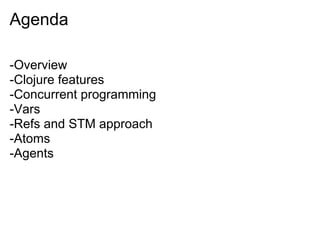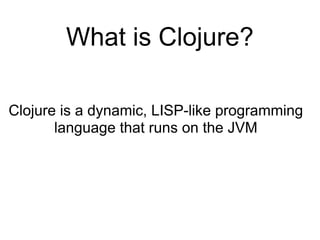Clojure concurrency overview
- 2. Agenda -Overview -Clojure features -Concurrent programming -Vars -Refs and STM approach -Atoms -Agents
- 3. Overview Rich Hickey https://twitter.com/#!/richhickey -about 2.5 years working on Clojure -first public release at 2007 -interview: http://www.simple-talk.com/opinion/geek-of-the- week/rich-hickey-geek-of-the-week/
- 4. What is Clojure? Clojure is a dynamic, LISP-like programming language that runs on the JVM
- 5. How does it look? Exactly! Like LISP
- 6. A form is a list where the first symbol in the list has to be a special word that the compiler can understand - usually the name of a function
- 7. Clojure Features ● Functional ○ Immutable, persistent data structures ○ Functions are objects ● Lisp ● Hosted on JVM ○ the same memory model ○ garbage collector ○ etc ● Supporting Concurrency ● Open source
- 8. Clojure Features ● Dynamic development ○ REPL (read-eval-print-loop), on-the-fly compilation to JVM bytecode ● Full set of immutable, extensible, read-only data structures: ○ lists ○ maps ○ sets ○ vectors ● Macros
- 9. Clojure Features Java interop ● Call java-methods, access fields ● Functions implement java.util.concurrent. Callable (defn func (smthng)) ● Proxy interfaces/classes ● Primitive types - int, long, byte, Char, String etc ● Clojure data structures implement Collection, Iterable, Comparable etc
- 10. Concurrent programming ● Things are happening at the same time ● Number of CPU is growing fast
- 11. Concurrent programming problems Visibility problem ● Multiple threads use shared data ● 2 or more threads are trying to change the same data at the same time
- 12. Concurrent programming problems Basic solution is ● locks ● synchronized access ● only one thread can have lock, others blocks ● But it requires additional efforts ○ thread-coordination ○ avoiding deadlocks
- 13. Concurrent programming problems Access problem ● several threads are trying to access and change the same shared data at the same time ● write/read at the same time ● readers block readers
- 14. Clojure way ● There is no any possibility to change data by direct access. All data structures are immutable, remember? ● Only read, if we add element - new data structure will be created. ● No locks ● No access problems
- 15. But what if we really want change data in Clojure? This opportunity is also provided by the language! All hard work done for us.
- 16. Reference types ● Vars ● Refs ● Atoms ● Agents
- 17. Vars ● Reference to mutable storage location ● Dynamically rebound on a per-thread basis ● Functions are vars, so they can be dynamically rebound too ● Ensure safe use via thread-isolation (def x 5) // root-binding (x) // 5 .... (binding [x 20] (+ x 1)) // 21 .... (x) // 5 again, not changed
- 18. Changing Vars (set! var-name new-value) ● cannot change root-binding ● works only in thread-local context (in "binding") (def x 5) // root-binding (set! x 7) // exception will be thrown .... (binding [x 20] (println (+ x 1)) // 21 (set! x 10) (+ x 5)) // 15 .... (x) // 5 again, not changed
- 19. Refs ● Based on Software Transactional Memory (STM) ● Change the value by applying a function to old value ● Refs can be changed within a transaction only ● Transactions will be retried automatically if conflict happens ● To make changes code must be surrounded with (dosync ...) ● All changes are atomic
- 20. Refs (def r (ref '(1 2 3))) (deref r) // list (1 2 3) (dosync // transaction begins .... (alter r // change ref! (fn [_] '(10 9 8)) ... ) // transaction ends (deref r) // list (10 9 8)
- 21. Refs lifecycle (def r (ref '(1 2 3))) (deref r) (dosync .... if any other transaction (alter r commutes - this (fn [_] '(10 9 8)) transaction is repeated ... ) Otherwise, that's ok and (deref r) programs continues execution
- 22. Atoms ● Way to manage shared state synchronously ● Change the value by applying a function to old value ● This is done in an atomic manner by function swap! ● Internally, swap! reads the current value, appliesthe function to it, and attemprs to call compare-and-set! for this atom
- 23. Atoms best practices by Rich Hickey (defn memoize [f] (let [mem (atom {})] (fn [& args] (if-let [e (find @mem args)] (val e) (let [ret (apply f args)] (swap! mem assoc args ret) ret)))))
- 24. Atoms best practices by Rich Hickey (defn fib [n] (if (<= n 1) n (+ (fib (dec n)) (fib (- n 2))))) (time (fib 35)) user=> "Elapsed time: 941.445 msecs" (def fib (memoize fib)) (time (fib 35)) user=> "Elapsed time: 0.044 msecs"
- 25. Agents ● Asynchronous changing. They are not blocking main execution, return immediately ● Change the value by applying a function to old value ● Agent action dispatches take the form (send agent fn args*) ● If other actions try to change data - they will be added to the queue
- 26. Agents (def a (agent 5)) // create agent (deref a) // 5 (send a (fn [old-val] (+ old-val 5))) (deref a) // may be 5, or may be 10 (Thread/sleep 1000) (deref a) // 10
- 27. Useful links ● https://groups.google.com/forum/#!forum/clojure ● http://clojure.org ● http://alexott.net/ru/clojure/index.html ● http://www.lisperati.com/clojure-spels/casting.html ● http://www.pluralsight-training. net/microsoft/courses/TableOfContents? courseName=clojure-concurrency-tutorial
- 28. Q&A

















![Vars
● Reference to mutable storage location
● Dynamically rebound on a per-thread basis
● Functions are vars, so they can be dynamically rebound too
● Ensure safe use via thread-isolation
(def x 5) // root-binding
(x) // 5
....
(binding [x 20]
(+ x 1)) // 21
....
(x) // 5 again, not changed](https://image.slidesharecdn.com/clojureorg-120130232522-phpapp02/85/Clojure-concurrency-overview-17-320.jpg)
![Changing Vars
(set! var-name new-value)
● cannot change root-binding
● works only in thread-local context (in "binding")
(def x 5) // root-binding
(set! x 7) // exception will be thrown
....
(binding [x 20]
(println (+ x 1)) // 21
(set! x 10)
(+ x 5)) // 15
....
(x) // 5 again, not changed](https://image.slidesharecdn.com/clojureorg-120130232522-phpapp02/85/Clojure-concurrency-overview-18-320.jpg)

![Refs
(def r (ref '(1 2 3)))
(deref r) // list (1 2 3)
(dosync // transaction begins
....
(alter r // change ref!
(fn [_] '(10 9 8))
...
) // transaction ends
(deref r) // list (10 9 8)](https://image.slidesharecdn.com/clojureorg-120130232522-phpapp02/85/Clojure-concurrency-overview-20-320.jpg)
![Refs lifecycle
(def r (ref '(1 2 3)))
(deref r)
(dosync
....
if any other transaction
(alter r
commutes - this
(fn [_] '(10 9 8))
transaction is repeated
...
)
Otherwise, that's ok and
(deref r) programs continues
execution](https://image.slidesharecdn.com/clojureorg-120130232522-phpapp02/85/Clojure-concurrency-overview-21-320.jpg)

![Atoms best practices by Rich Hickey
(defn memoize [f]
(let [mem (atom {})]
(fn [& args]
(if-let [e (find @mem args)]
(val e)
(let [ret (apply f args)]
(swap! mem assoc args ret)
ret)))))](https://image.slidesharecdn.com/clojureorg-120130232522-phpapp02/85/Clojure-concurrency-overview-23-320.jpg)
![Atoms best practices by Rich Hickey
(defn fib [n]
(if (<= n 1)
n
(+ (fib (dec n)) (fib (- n 2)))))
(time (fib 35))
user=> "Elapsed time: 941.445 msecs"
(def fib (memoize fib))
(time (fib 35))
user=> "Elapsed time: 0.044 msecs"](https://image.slidesharecdn.com/clojureorg-120130232522-phpapp02/85/Clojure-concurrency-overview-24-320.jpg)

![Agents
(def a (agent 5)) // create agent
(deref a) // 5
(send a
(fn [old-val]
(+ old-val 5)))
(deref a) // may be 5, or may be 10
(Thread/sleep 1000)
(deref a) // 10](https://image.slidesharecdn.com/clojureorg-120130232522-phpapp02/85/Clojure-concurrency-overview-26-320.jpg)

